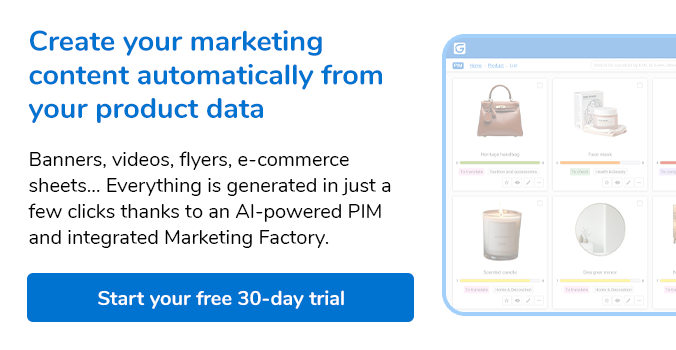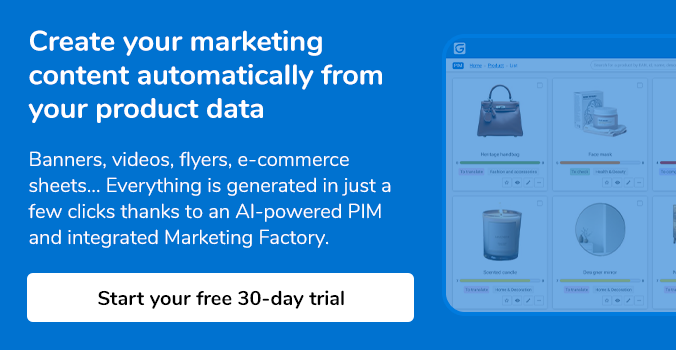Product Information Management definition
Product Information Management, often shortened to PIM, is a software solution enabling the centralization, improvement and distribution of product data.
While Product Information Management – PIM – is particularly suited to businesses managing large volumes of data, product information management can concern all types of business (large or small), or activity (Industry, Publishing, Tourism, Energy, Retail…). Installing Product Information Management software involves several teams within the company: Marketing, Product, Sales, Procurement…
In an omnichannel strategy, Product Information Management software gets the right information to the right place to provide the buyer with a consistent and personalized product experience. Although today it is considered that the buyer makes the decisions, businesses are increasingly looking towards PIM software to gain control over the customer journey from start to finish: provide detailed and complete product information, check the accuracy of data, adapt contents to each selling channel…
#Why use Product Information Management software?

The explosion of eCommerce has given rise to new expectations among buyers. 95% of consumers consider that the available product information is essential or even decisive in their decision to buy1. More demanding and better informed, they want access to product data that is more detailed, more relevant and more reliable. These changes have led to businesses completely overhauling their marketing strategies. These new challenges are pushing them to constantly renew themselves to provide a personalized and consistent product experience on all selling channels.
The challenge is huge for companies managing thousands of different product references, each with a multitude of data: features, attributes, images, technical specifications… In the eCommerce industry, Product Information Management software has become a “Must-Have” to organize and structure this data.
#What are the key features of a Product Information Management solution?
#Centralize product data in a single repository
In any company, information is generally spread among different information sources such as the ERP (production data), CRM (sales data), Excel files or in various websites (CMS, eCommerce platforms…). This scattering of information within the company increases the risk of error: complicated file exchanges, inconsistent data, duplication of information… and these errors generate a negative impact on the consumer's image of the brand.
To provide a bird's-eye view of their product offer and to reduce errors, businesses are opting for Product Information Management solutions. Recognized for their power to centralize data, a PIM solution enables a company to manage all the data relating to a product, through one central repository: marketing copy, technical and logistics data… This reduces the risk of human error by using a single central database provided by the Product Information Management software.
#Enrich product data collaboratively
After implementation, the PIM software enables Marketing, Product and Sales teams to work together, using a central repository, to generate and distribute product data. It is essential that enrichment and distribution of product data be managed properly to improve the product experience. For example, adding a product video can increase eCommerce orders by up to 144%2.

Workflow and product data quality control features enable the company's teams to contribute collaboratively to provide relevant and comprehensive product information for the consumer. Depending on their user rights, each contributor can enrich product data: complete a marketing description, add a new product classification or family, or control the quality and accuracy of data before publishing on eCommerce websites or in a catalog.
#Disseminate product data precisely and efficiently
Product Information Management software enables you to disseminate product information accurately and efficiently on all publication channels, be they print (PDF price catalogs, technical brochures, flyers…) or digital (online product catalogs, product datasheets on a Marketplace or eCommerce platform…).
PIM software contains the accurate and comprehensive version of your product data: from which you can create targeted print or digital catalogs for all your sales points (stores, trade fairs, eCommerce site, marketplace…).
#Product Information Management software: a competitive advantage for eCommerce businesses
#Customize your product information
In the eCommerce industry, it has become crucial to customize product data. According to a survey run by Shopify3 key shopping periods like Black Friday, Cyber Monday or Christmas are extremely busy times for eCommerce. This survey illustrates the importance of adapting the product catalog quickly to each different period or situation.
In this context, using Product Information Management software allows businesses to react quickly to get ahead of the competition. Launching a product range for a new target, penetrating a new market abroad, special offers for key seasons… If your product catalog is constantly changing, the PIM allows you to adapt your product data to each sales context.
#Opt for an omnichannel approach
84% of today's consumers say that they want a personalized shopping experience, consistent on all sales channels4. To meet these new expectations, businesses need to present product information that is specifically adapted to each channel (eCommerce sites, marketplaces, stores…).
Considering the multiplication of selling channels, businesses are increasingly using Product Information Management software as a core element of their information system to manage product data efficiently on all points of sale. The Goaland PIM has numerous connectors customizable import and export for Excel (native), CSV and XML, API REST webservices, eCommerce connectors including Prestashop and Magento enabling it to interface with your third party applications. You can now send product data accurately and efficiently to all your websites (CMS, eCommerce platforms), mobile applications, distribution networks (XML flow, APIs) or automated page layout tools.
1
J. (2017, 01).eCommerce : 10 figures illustrating the importance of a good content strategy.frenchweb.fr.
2
Key eCommerce figures for France in 2019. ca-moncommerce.com.
3
(2019, 06).eCommerce : a survey by Shopify paints a portrait of the e-buyer. presse-citron.net.
4
Magana, G. (2019, 03). New study shows consumers want seamless multichannel e-commerce. businessinsider.fr/us.







